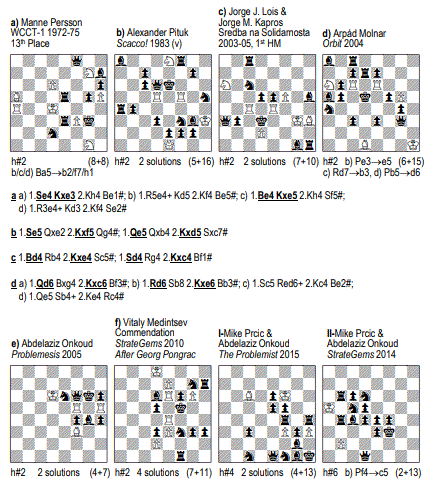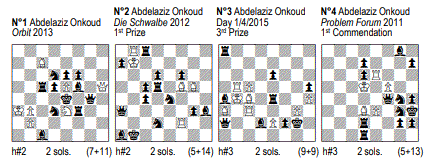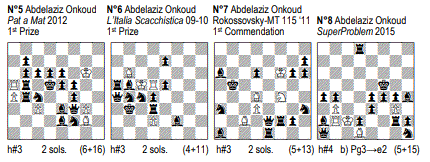King versus Rooks
By Abdelaziz Onkoud
StrateGems N° 70 , April- June 2015

[Editor’s note. A recent group of helpmate problems, featuring King vs. Rooks, by the renowned Moroccan composer, Abdelaziz Onkoud, prompted me to ask Abdelaziz to describe this interesting condition with examples. I have dubbed this condition The Onkoud Theme.] Definition: Two Rooks are captured by opposing Kings after the line between them is closed by the pieces of the same or opposing colors.

A - Predecessors Before going any further, I would like to show you six problems which feature the King vs. Rooks mechanism . A few weeks later we composed a double Rundlauf of the White King using the same (King vs. Rooks) mechanism (See diagram II). Afterward, I concentrated on composing problems by using the full extend of this mechanism.

B - The birth of the King vs. Rooks mechanism In October 2014, Mike Prcic emailed me a h#4 with one solutions. It had a black Bishop rundlauf. He asked me to look for possible improvements. A day later I found a second solutions and introduced a mechanism based on the capture of two black Rooks by the white King, after closing the lines between black Rooks by two different black pieces on the same square g4 (See diagram I).
C – The definition of the King vs. Rooks mechanism Two Rooks of the same color are captured by the opposing King after the line between them is closed:
- - by the pieces of the same color (Forms I and VI)
- - by the pieces of opposite color (Forms II and VII)
- - by the pieces of both colors (Forms III and VIII)
- - by the same piece (Forms IV, V, IX and X)
Here are the different forms of the mechanism
- Form I: A closing of black Rooks’ lines by two black pieces.
- Form II: A closing of black Rooks’ lines by two white pieces.
- Form III: A closing of black Rooks’ lines by one black and one white piece.
- Form IV: A closing of black Rooks’ lines by the same black piece.
- Form V: A closing of black Rooks’ lines by the same white piece.
- Form VII: A closing of white Rooks’ lines by two black pieces.
- Form VIII: A closing of white Rooks’ lines by one white and one black piece.
- Form IX: A closing of white Rooks’ lines by the same white piece.
- Form X: A closing of white Rooks’ lines by the same black piece.







